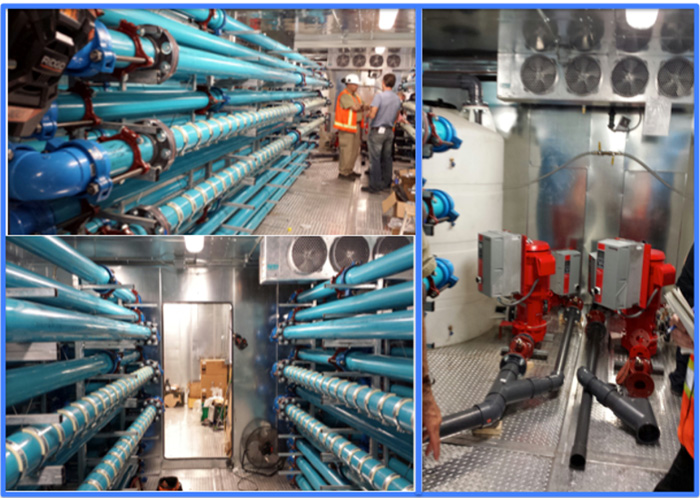|
|

|
  
Features
Update 2020/2/10
ANTIBIOTICS IN YOUR PIPES? QUEEN’S UNIVERSITY PHD CANDIDATE WORKS TOWARD SOLUTIONS
By Suzanne Forcese
The widespread use of antibiotics has been crucial in the war on many forms of bacterial infection from those that are mild to those that are dangerous and even life-threatening. But the new superbugs have developed antibiotic resistance. In other words, they are no longer suppressed by drugs.
In much the same fashion that these superbugs have outwitted science’s tactics to halt their spread, a new type of resistance is evolving in drinking water distribution networks. In our drinking water distribution systems micro-organisms are normally treated with chlorine and UV radiation. However, there is evidence to suggest they are now surviving the onslaught of chemical treatment. |  |
WaterToday spoke with PhD Candidate, Alexandria Cushing in the Beaty Water Research Centre (BWRC) at Queen’s University, Ottawa. Cushing, whose engineering studies began with a bachelor’s degree in Environmental Engineering from Carleton University told WT, “I wanted a different experience with water and engineering.” She found that challenge at Queen’s University where she earned her Master of Civil Engineering.
Now for the present challenge, Cushing works under the supervision of Dr. Yves Filion and Dr. Pascale Champagne (her two superheroes), researching biofilm growth within Canadian drinking water distribution networks.
|
“My goal has always been to make clean water available to those less fortunate than myself. But I cannot slay the dragon alone. It needs to be a collaborative effort,” Cushing explains as her reason for being involved with research at BWRC.
The progressive vision of the Beaty Water Research Centre is a perfect fit for Cushing. As stated on the BWRC website: “Water-related issues are a driving force for economic growth, social well-being, and a healthy population in Canada and around the world….BWRC is an inter-disciplinary research centre dedicated to furthering these interests and is committed to fostering an environment that encourages collaborative research spanning both traditional water-related disciplines, as well as non-traditional and emerging disciplines.”
“Understanding the issues involved with our drinking water starts in the community,” Cushing adds. “We also need to involve the community in the solution. As an engineer I can also be involved in all the roles of finding a solution.”
The issue now is examining the micro-organisms that have formed a biofilm on the inside surfaces of water pipes. “The micro-organisms are surviving the UV radiation and chlorine and attaching themselves to the rough surfaces of the pipe walls.”
“The biofilm is a very adsorbant material.” Pharmaceuticals in the water supply will readily attach to the biofilm. “If antibiotics enter our water either through excretion or by people flushing unused drugs down the toilet our current wastewater treatments are unable to deal with this. These micro-organisms will grab onto the antibiotics.”
If the micro-organisms break off from the walls of the pipes and enter the ground water and move into our drinking water then consumers would be unwittingly drinking antibiotics.
“So, let’s say for example,” Cushing adds, “someone who has been drinking that water will become resistant to antibiotic treatment. They might get a cut that becomes infected and antibiotics would not clear it up.”
Most municipalities flush out their systems with increased pressure but Cushing says “there is still biofilm on the pipe walls.” At present the only options to remove the biofilm are to replace cast iron pipes with smoother plastic pipes that would prevent the micro-organisms attaching; or, to put a plastic liner inside the pipes.
“But how do you get inside without digging up the pipes? And how often does it need to be done? There is a huge expense involved.”
Similarly, how do you get to the biofilm to study it? “Because these micro-organisms live in a nutrient deficient environment it could take years for a large enough mass to break off. The only way to study them in the field is to wait for a water-main break.”
Fortunately, with the help of federal and provincial funding Dr. Filion’s lab has a large-scale pipe research facility that will allow Cushing and other students to examine the influence of fluid flow and water quality conditions on biofilm growth and mobilization in pipes.
Ultimately the research goal is to help evaluate the effectiveness of new pipe liner technologies and other strategies in improving water quality.
Questions that Cushing will be addressing are:
- What kind of material accumulates on the pipe wall
- What mechanisms are responsible for accumulation
- What hydraulic disturbances can mobilize wall material into water
- How does temperature influence growth rate

The facility comprises 2 large scale pressurized pipe test rigs inside the environmental chamber. Each pressurized pipe rig is comprised of looped 100 mm diameter PVC pipe. Variable-speed pumps are used to simulate a wide range of conditioning and flushing flows. Each pipe rig is equipped with instrumentation to measure water quality parameters. The rig also includes removable coupons to examine microbiologically active material that may be attached to the pipe wall.
The environmental chamber is designed to vary the water temperature between 4? to 20? to examine microbiologically active material that can accumulate on the pipe wall under different environmental conditions.
“The average temperature in most systems in Canada is 8?. We are raising temperatures to 20? in our experiments.” Cushing explains that normal tap water will be used as wells as water from the Cataraqui Stormwater Pond and recirculated through the completely closed system using granular activated carbon filters.”
“It’s still early stages,” Cushing says. “Once we can let the micro-organisms grow and take samples we can determine the number of different species and how abundant the structures are.”
It will be the foundation work that upcoming students can build upon.
Cushing will have her PhD in 2022 and from there she is looking to work in the water and wastewater industry. Wherever her destination, her main goal is “to give back to the community with technical knowledge.”
suzanne.f@watertoday.ca
|
|
|
Have a question? Give us a call 613-501-0175
All rights reserved 2025 - WATERTODAY - This material may not be reproduced in whole or in part and may not be distributed,
publicly performed, proxy cached or otherwise used, except with express permission.
|
| |